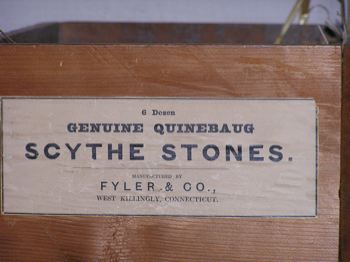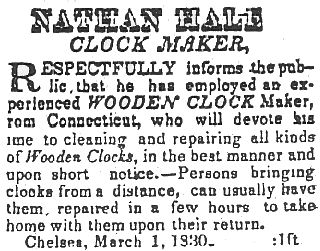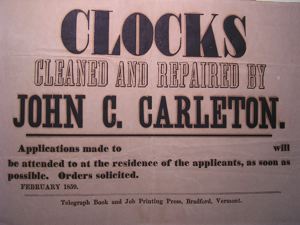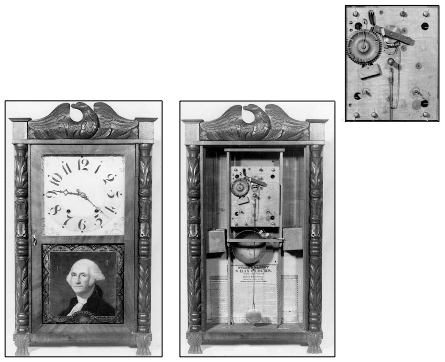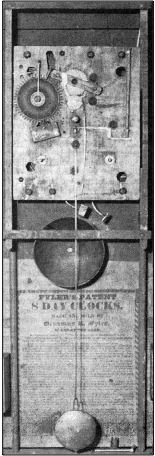
© Donn Haven Lathrop 2003
Orsamus Roman Fyler of either Connecticut or Vermont is one of those shadowy clockmaker figures who seems to abruptly (and randomly) pop up in our horological consciousness---and then quietly fade away--usually when someone comes across one of his clocks, asks for information on him, and is told that there is little information to be had. Truth to tell, there just isn't all that much information available--but he keeps on popping up in research on clockmakers in New England. A search through the BULLETIN Index yields some 33 references, beginning in 1954 and running through 1995, primarily concerning his clocks and his patents. There are but two articles that have any sort of biographical information---one of these is dead wrong, the other1 has a couple of errors---and there's nothing much at all about his clockmaking. George Eckhardt's2 book on clock and watch patents has two listings for Fyler:
MANUFACTURING WOODEN CLOCKSIn the second of the two listings above, the surname is misspelled 'Tyler.' Whether the original documents carried this spelling is unknown; the Patent Office burned in 1836, and everything went up in smoke. However, the text of these two patents appears as an Appendix to the book.3>
Fyler, O. R. Chelsea, Vt. Jun. 13, 1831-
CLOCK ESCAPEMENT
Tyler, O. R. Bradford, Vt. Sep. 6, 1833-
1 The locations given by Richard F. O'Connell in BULLETIN #119, Pg. 40, should be "...Chelsea, and Bradford, Vermont, and Newfield, Connecticut. James W. Gibbs in BULLETIN #184, Pg. 433, writes of Fyler as Orsamus J. Tyler.
2 George Eckhardt: Unites States Clock and Watch Patents, 1790 - 1890. The Record of a Century of American Horology and Enterprise.. Fyler is the Orsamus J. Tyler given by Gibbs. Incidentally, the listings in this book have been scanned and have been made available to the NAWCC Library for a quick computerized search.
3 See also BULLETIN #294, Pg. 75, for the text of his first patent. Somehow copies of these two patents ended up in the Franklin Institute Library in Philadelphia, where Mr. Eckhardt found them.
1
Orsamus Roman Fyler, son of Roman and Hannah (Barton) Fyler was born 4 November, 1793, at Newfield, Connecticut (near Torrington). Lane Kendall Fyler, (a descendant of Fyler's half-brother4), and the genealogist for the Filer/Fyler family, wrote:
"He did not marry but was a man of energy and character. He was the first inventor of a clock to run 8 days in a short case. He manufactured whetstones (author's emphasis) and later became interested in selling the Guinabang Whetstones."
Zadock Thompson wrote the below thumbnail sketch of Burke in his 1842 History of Vermont:
"In 1817, Roman Fyler and others, established a manufactory of shaving boxes and brushes here, and for several years manufactured these articles to the amount of from $1,000 to $2,000 annually. (Orsamus did not grow up in a poor household, regardless of its primitiveness.) In 1819 Mr. Fyler and sons (author's emphasis) commenced the preparation of oil stones, in this town. The stone was procured from a small island (known as Whetstone Island) in Memphremagog lake, and was here prepared for use and then sent to market in the amount of three or four tons annually. It has been considered nearly, or quite equal to the Turkey5 oil stone, and is generally known by the name "Magog oil stone."
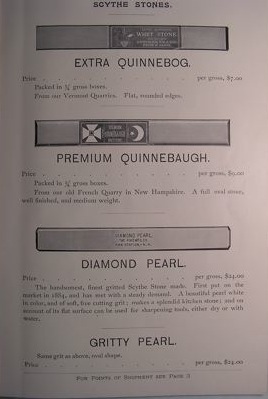
Figure 1. A page from a catalog illustrating some of the sharpening stones from various quarries.
'Guinabang' Whetstones? I spent frustrating weeks (and in the process got the State Geologists for both Connecticut and Vermont all wound up) looking for the source of these whetstones, only to
4 Hannah Fyler died of complications of childbirth on 14 November, 1795, and Roman married a Mrs. Sally Lyman (widow) in Newfield on 26 March, 1797. If some of this material sounds familiar, both Paul Hollingshead (BULLETIN #56, Pg. 313) and I are quoting from the same material.
5 Turkey stone is a stone imported from Turkey. It is a novaculite, a hard, extremely fine-grained siliceous rock known in this country as Arkansas stone.2
find that "Guinabang" appears to be an orthographic error by Mr. Fyler carried over into the article in BULLETIN #56---these whetstones were quarried and prepared in Northeast Connecticut in the Quinebaug area, and were known as Quinebaug Whetstones.
